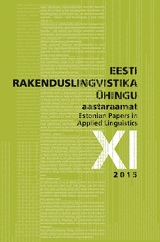Evidentsiaalsuse ja episteemilise modaalsuse suhetest eesti lastekeeles:
Evidentiality and epistemic modality combine in the Estonian morpheme -vat but are different categories in acquisition:
Experimental evidence
Author(s): Anne Tamm, Reili Argus, Airi Kapanen, Andra Kütt, Kadri SuurmäeSubject(s): Morphology, Semantics, Language acquisition, Pragmatics, Sociolinguistics
Published by: Eesti Rakenduslingvistika Ühing (ERÜ)
Keywords: language acquisition; semantics; pragmatics; morphology; Theory of Mind; experimental methods; Estonian;
Summary/Abstract: Since Aikhenvald 2004, evidentiality has been severed from epistemic modality. We studied the evidential and epistemic modal aspects of the Estonian evidential -vat experimentally and on the basis of a corpus study. We designed two experiments to separate the two categories. Four-, six-, and nine-year-old children were first asked to identify the source of the information provided with the morpheme. Then they performed a forced choice task guided by grammar: affirmative indicative, negative, and evidential sentences. Four-year-olds did not understand the evidential and modal -vat. Six year-olds showed an increased understanding of the evidential meaning but not the modal meaning or use. Nine-year-olds demonstrated full understanding of the evidential and an increased understanding of the epistemic modal aspect of the evidential. Estonian children thus develop the correct understanding of the morpheme -vat as an epistemic modal only after learning its evidential meaning.
Journal: Eesti Rakenduslingvistika Ühingu aastaraamat
- Issue Year: 2015
- Issue No: 11
- Page Range: 263-280
- Page Count: 18
- Language: Estonian

